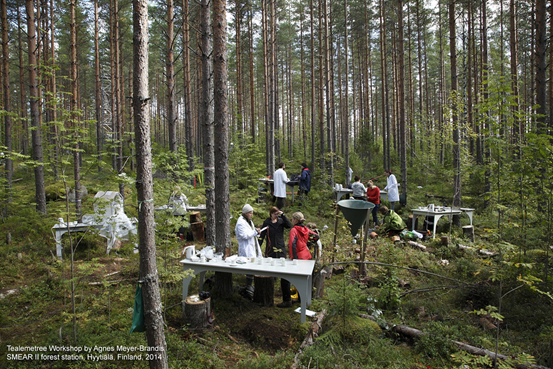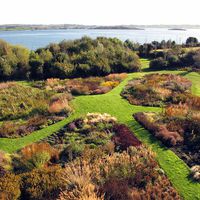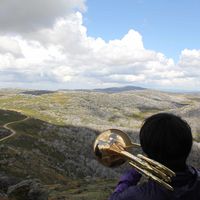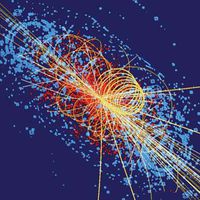#art&technology: Making space for dialogue between art and science

In culture360.ASEF.org’s new series of articles on #art&technology, making art in the nexus with scientific concepts requires time, dedicated research and a willingness for open dialogue. In this article, Claire Wilson interviews curator Ulla Taipale who shares some of her experiences engaging with the sciences.
As an artist, it can be difficult to know where to start when engaging with the sciences. One way is through residencies and programmes that are embedded in scientific processes, such as those at Arts at CERN (the European Organisation for Nuclear Research), the Belgium platform for art, science and technology Gluon, and Ars Electronica’s Futurelab, an artistic-scientific think tank and studio-lab. But working in this nexus of art and science is not necessarily easy.
Ulla Taipale is a Finnish curator, artist and researcher who has worked in the nexus of art and science for many years, fostering dialogue between artists, creators, scientists and the general public through creative interventions and educational projects.
In 2005 in Barcelona, she launched Capsula with curator Mónica Bello, a non-profit organisation that combines arts, natural sciences, nature and technology. Since 2008, Taipale has been working on a number of projects such as Capsula Curated Expeditions, Climate Whirl, an arts programme and artist-in-residence at the University of Helsinki’s Hyytiälä forestry research station, a collaboration with Arts at CERN, Melliferopolis – Honeybees in Urban Nature, Pixelache network, as well as launching the Biofilia – Base for Biological Arts at Aalto University and collaborating with the Master of Landscape Architecture (MBLandArch-ETSAB-UPC) in Barcelona. Taipale is currently an Art and Science curator at INAR (Institute for Atmospheric and Earth Science Research) at University of Helsinki.

Ulla Taipale, Photo by Tommi Taipale, 2019
Drawing from this vast experience, Taipale talked about some of the ways of working in the arts-science nexus.
Encountering art in diverse spaces
Dedicated to creatively exploring natural sciences, nature and technology, Taipale often works outside the gallery context. As an example, the project Melliferopolis – Honeybees in Urban Nature created a space of encounter in city parks, botanic garden and cemeteries, bringing experimental apiaries and art to dog walkers, neighbours, botanists and mourners.

Hexa-Hive Village with Airstrip for Pollinators is a Melliferopolis installation at a public park in the heart of Helsinki. This open-air installation features experimental hives for bees and citizens, and a flowerbed with a selection of melliferous plants. (Photo Credit: Ulla Taipale)
As Taipale explains:
‘Instead of being an exhibition curator that creates concepts for new exhibitions and looks for ready artworks to exhibit, I tend to dynamise and make new artworks happen, in the sense that I open up opportunities for artists to work in dialogue with scientists and research centres. The places where very often these things are happening, more than museums or art institutions, is biological field stations, botanic gardens and public parks, among others. These are places where they have some kind of infrastructure, but they happen in open air and in nature. I find this more interesting than to work with the white cube.’
This is not to say that Taipale doesn’t work with museums and cultural institutions, but rather this is just one part of a holistic practice that explores diverse spaces.
Another example is the Climate Whirl arts programme, based in the University of Helsinki’s Hyytiälä forestry research station in central Finland. The station is a center of international multidisciplinary research. Current topics cover many aspects of Earth system ranging from the depths of soil to atmospheric processes. The station is located in the middle of state-owned forests and peatlands, approximately one hour north-east drive from the city of Tampere. The arts programme has invited artists to work alongside scientists since 2013 and in 2019, they launched the first open call. Although work created during Climate Whirl has been exhibited widely, the aim of the project is also to have something permanent in the station, something left behind. The idea behind this is to place artwork in an unexpected space, a space where those who come to the forest station (such as scientists, university students, school groups or researchers) can come across art as a counterpoint to their own interactions with the forest.
Creating a dialogue between artists and scientists
In focusing on the creative process, Taipale emphasises the importance of dialogue, more so than collaboration. As she explains ‘it doesn’t have to be collaboration, it’s more like dialogue, because collaboration maybe means that there will be some kind of end result together.’ The arts-science projects that Taipale has worked on as a curator have been positive, but she points out that this is partly because the artists have been very successful at creating a dialogue.
Establishing this discussion isn’t always easy; people are busy and for scientists, it isn’t a priority to have conversations with an artist or share information. In order for it to be successful it is important to study well before approaching scientists. ‘If you start making questions that are not interesting, the other party notices that you didn’t research what you want to know yourself first,’ Taipale explains. ‘There is a lot of information out there… you have to first think what kind of information you need and also make the counterpart interested in what you are doing and how this information is going to be used.’
This is particularly the case for working with scientists who aren’t familiar with artistic processes. While setting up Biofilia, a learning and research laboratory at the intersection of art, life sciences and technology at Aalto University, Taipale had discussions with scientists at the university who hadn’t worked with artists before. It became clear that there is often a misconception about how artists can work with scientific projects, in that there was a belief that artists will simply document or illustrate the scientists working.
There is a tradition of science illustration or science documentation, but contemporary artists have the potential to delve much deeper than this. It is up to the artist to initiate the discussion and find ways to engage meaningfully with the scientific work.
German artist Agnes Meyer-Brandis fostered dialogue with the researchers at the Hyytiälä forestry research station through inviting them to ‘Have a Tea with a Tree’. The resulting work that was installed in the forest, Permanent Tealemetree Station (a table wrapped around a tree in the middle of the research forest) symbolises the impact these dialogues can have.

Tealemetree Workshop lead by Agnes Meyer-Brandis, Hyytiälä Forestry Field station in the framework of Climate Whirl artist-in-residence. (Photo Credit: Agnes Meyer-Brandis, © VG Bildkunst, 2014)
As Taipale explains, ‘In this station, people normally come from all over the world, they come for a couple of days and of course they are very concentrated on their work – they meet with their colleagues, conduct measurements, go to sauna, they sleep, and then they go away. So then how is it possible to create conversations with the people who are not expecting to talk and have a tea with an artist who has a residency there?... Mostly the conversations happen in a boring office that are not inspiring at all. So, the idea [of the artwork] was to be in the middle of the forest and have a relaxed moment, with a tree and a cup of tea. It was a symbol for creating a good atmosphere for any kind of exchange of ideas…where both sides are getting something.’
Although dialogue is a cornerstone of this kind of work, Taipale highlights that there are many approaches to science-arts projects that can be successful. Some artists approach their work in a very ordered way, knowing what kind of information or outputs they are looking for from the beginning. Some artists are more dependent on the work of the scientists, documenting their processes, while others need detailed knowledge of working with specific equipment before they can take their creative project further.
At the heart of these projects is the artists’ creative practice and their ability to use the scientific information to inform their work while exploring their own creative direction. As Taipale emphasises, artists need to have the freedom to ‘use the imagination and put another dimension there,’ as this is the real contribution they can make – using creative expression to bring a new perspective.
Becoming familiar with the science
Research is another important element of working with scientific concepts. Rather than being reactive and documenting the way scientists work, Taipale recommends becoming familiar with the science. ‘If you go to one of these research stations or laboratories your eyes are full of strangeness.’ While this strangeness can be fascinating, the creative work can become more impactful with deeper knowledge.
For artists working in laboratories where a higher level of technical knowledge is required, it’s important to spend time getting to know the area well until ‘it’s not this pure fascination of something that’s a bit alien for your life. So it’s then, when you start to understand, when you start to assume this knowledge and start to find the nuances, then you know what direction your work is going to take you will create from there. It’s not easy at all.’
As Taipale points out, in these laboratories there is such a huge amount of information that you have to be a machine to be able to take it all in and produce an artwork all in the time of a month residency. ‘Maybe you go with a certain idea but then when this big celebration of input finishes, to able to select one topic or the area of topics that is going to be the theme for your artwork and to be able to go on from there, I think this is a challenge.’
This article is written by Claire Rosslyn Wilson, a freelance cultural writer, researcher and poet, living between Barcelona and Melbourne. She has particular interests in cultural diversity, experiences of place and creative expression for social change. She co-wrote ‘Freelancing in the Creative Industries’ (Oxford University Press, 2015) and has over ten years professional experience in the arts and resource development.
Similar content
deadline
18 Nov 2019
deadline
30 Oct 2015
deadline
30 Jan 2022
21 Jan 2019
deadline
10 Nov 2011
deadline
20 Jan 2015






